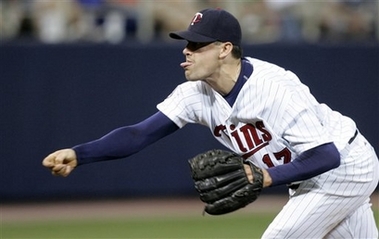September 30, 2007
Breaking Down The Bullpen
YEAR ERA IP SO BB HR AVG OBP SLG
2006 2.91 498.0 450 137 39 .248 .301 .359
2007 3.87 469.1 384 171 55 .255 .325 .400
Even at 6.02 WPA the Twins' bullpen ranked as the sixth-best in baseball, but at 11.00 they led MLB by a wide margin in 2006. That 4.98 WPA decline ranked as the third-largest behind only the A's (8.31) and Yankees (8.04). In what isn't surprising given that they went from a fourth-place finish that included tons of blown leads to a division title, the Indians' bullpen experienced the biggest season-to-season improvement, going from -6.80 WPA in 2006 to 7.83 WPA in 2007 for an amazing jump of 14.63 WPA.
It's also interesting to note that MLB bullpens as a whole improved quite a bit compared to last season, which suggests that either teams are doing a better job of deploying their relievers or relievers simply had a good year. A dozen teams saw their bullpen improve by at least 3.00 WPA this season, whereas the Twins were among just six teams that saw their bullpen decline by at least 3.00 WPA. For the Twins relievers who were around in both 2006 and 2007, here's a look at how they fared:
2006 2007 DIFF
Pat Neshek 1.10 2.83 +1.73
Matt Guerrier 0.43 1.61 +1.18
Glen Perkins 0.09 0.35 +0.26
Jesse Crain -0.17 -0.28 -0.11
Joe Nathan 5.13 3.63 -1.50
Dennys Reyes 1.47 -0.42 -1.89
Juan Rincon 2.38 -0.46 -2.84
TOTAL 10.43 7.22 -3.17
Joe Nathan's decline was a big one, but he actually just went from extraordinary to merely excellent. In 2006, Nathan's 5.13 WPA ranked third among all MLB relievers. This year, Nathan's 3.63 WPA ranked seventh among all MLB relievers. Dennys Reyes experienced an even bigger decline than Nathan as he struggled with injuries and predictably came crashing back down to earth after posting a 1.47 WPA and 0.89 ERA in 2006.
Along with Nathan remaining one of baseball's elite closers, the big improvements from Pat Neshek and Matt Guerrier are what kept the Twins' bullpen as a major strength. Neshek was fantastic last season, but spent half the year at Triple-A. This season he was in the Twins' bullpen the entire time and ranked 10th among MLB relievers with a 2.83 WPA. Meanwhile, Guerrier went from being a solid middle reliever (0.43) to a good setup man (1.61), ranking 18th among non-closer relievers in WPA.
 Neshek and Guerrier combined for a massive 2.91 WPA jump, but Juan Rincon's 2.84 WPA decline essentially canceled that out. Last season Rincon's 2.38 WPA ranked 17th among all MLB relievers and fifth among non-closers, but it plummeted to -0.46 this year. As a group, the seven holdovers from 2006 saw their WPA decline by 3.17. To put that in some context, a 3.17 WPA would have ranked eighth among all MLB relievers, so the decline was essentially like losing one elite reliever.
Neshek and Guerrier combined for a massive 2.91 WPA jump, but Juan Rincon's 2.84 WPA decline essentially canceled that out. Last season Rincon's 2.38 WPA ranked 17th among all MLB relievers and fifth among non-closers, but it plummeted to -0.46 this year. As a group, the seven holdovers from 2006 saw their WPA decline by 3.17. To put that in some context, a 3.17 WPA would have ranked eighth among all MLB relievers, so the decline was essentially like losing one elite reliever.
Of course, even the seven holdovers' 3.17 WPA decline accounts for just 64 percent of the bullpen's total dropoff. A small chunk of the decline (0.11 WPA, to be exact) came from starters who spent some time in the bullpen. In 2006, Carlos Silva, Matt Garza, Francisco Liriano, and Kyle Lohse fit into the "starters" group and combined for a 0.49 WPA as relievers. In 2007, Garza, Scott Baker, Kevin Slowey, Ramon Ortiz, and Boof Bonser fit into the "starters" group and combined for a 0.38 WPA as relievers.
That leaves 1.70 WPA worth of decline to account for still and it's pretty easy to spot. Aside from the aforementioned starters spending some time in the bullpen, the Twins used a grand total of just eight relievers in 2006 and all but Willie Eyre returned in 2007. However, because of injuries to Reyes and Jesse Crain, the Twins used a total of 11 relievers (again, not counting starters) this year. The "extra" relievers were Nick Blackburn, Julio DePaula, Carmen Cali, and Jason Miller.
They combined for a -1.62 WPA, which along with Eyre's 0.08 WPA as a mop-up man last season accounts for that "missing" 1.70 WPA dropoff. Most of that comes from DePaula's brutal -0.63 WPA in just 20 innings and Blackburn's back-to-back implosions that dragged him down to a horrendous -0.81 WPA in 11.2 relief innings. Toss in Cali's -0.23 WPA in 21 innings and the new guys did an awful lot of damage in limited action.
There is certainly no shortage of areas to point to when it comes to explaining how the Twins had their first losing season since 2000, but lost in the many obvious weaknesses is the fact that the bullpen went from being extraordinary to very good. Relief pitching remained a major strength, but the difference between being the absolute best in baseball and simply being among the best in baseball definitely cost the Twins wins.
Once you're done here, check out my latest "Daily Dose" column over at Rotoworld.

